Rose Laird (post 1935)
Continued from: Rose Laird
Rose Laird added some skin-care products to her range in the years leading up to the introduction of the Young Skin line for adolescents in 1938 which, it could be argued, was her most innovative addition to the beauty industry.
Skin-care
In 1936, Rose Laird added Solo Cream, a cleanser, and Solo Masque, a liquid mask. Both products were packaged using the green and white designs introduced in 1933.
The Solo Masque was painted on with the soft brush that accompanied the product, left on for ten minutes or so then wiped off with a damp cloth. Applying the mask produced a tingling sensation on the skin that was supposed to improved blood circulation. This suggests that it contained an irritant and functioned like a circulation cream.
Solo Cream: “Cleanse and enrich with a double-duty cream which coaxes your skin into velvet smoothness while keeping it immaculate.”
Solo Masque: “Stimulate with this quick, easily applied facial cocktail.”
Also see: Circulation Creams
In 1938, Rose Laird then debuted a new cream for dry skin. Recommended as a night cream it could also be used as a powder base where it produced a dull matt finish and as a skin protectant during cold, dry winters.
Dry Skin Cream: “[A] penetrating emollient designed to supplement natural oils.”
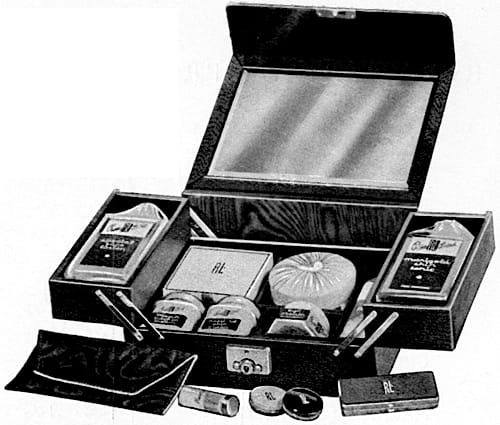
1938 Rose Laird Beauty Box.
The new lines were combined with existing products to create new treatments for Normal, Dry and Oily skin types.
NORMAL SKIN
Solo: The proven cleanser.
Am-ber-ain: “Wipes away” impurities dislodged by Solo.
Nutri-Ol: To impart to your skin a softness reminiscent of dawn.
Poudre Set: A semi-liquid cream to banish skin shininess, free from pore-clogging, skin-drying ingredients. applied after rouge it supplies a velvety matt finish. Three shades Lotus, Light Rusglo and Rusglo.
DRY SKIN
Solo: The perfect dry skin cleanser..
Dry Skin Cream: To loosen dry skin particles and pave the way for.
Nutri-Ol: Almond based for use on alternate nights, to soften and lubricate.
Marigold Skin Lotion: Softly effective as a tonic and helps coax dry skin to normalcy.
Special Face Lotion: Provides a protecting powder film to withstand the onslaughts of the elements.
OILY SKIN
Cream Vi-O-Lay: A practical emulsion so necessary as a cleanser to help the pores function normally.
Liquid Pore Cleanser: An invaluable preparation which cleanses the over-oily skin of impurities and helps keep complexion-texture satiny.
Cream for Oily Skin and Carbolised Skin Lotion: Alternate these nightly. The former helps normalize enlarged pores and is intended to promote regularity in oil gland activity. The later is a synchronised, special formula product useful for over-oily skin.
Special Face Lotion: An effective pore protection against grit and grime for this type of skin. Artfully conceals embarrassing skin blemishes and serves as an effective, year-round powder base. Can be used advantageously in any climate.(Rose Laird, c.1938, pp. 5-8)
Clients could buy the necessary requirements for each of these treatment regimes as kits, each kit containing enough cosmetics to last for one month. Kits were alks developed for: Acne, Pimples and Blackheads; Stimulation and Muscle Tone; Very Sensitive Skin; Freckles and Discoloured Skin; and Enlarged Pores and Coarse-Grained Skin. Some of these had been available earlier in the decade.
To get the most out of any of her skin-care treatments, Rose Laird continued to combine her pinching and knuckle massaging techniques with the facial exercises she had introduced earlier in the decade. She continued to promote the curative benefits of forceful massage which included scalp stimulation treatments for balding men.
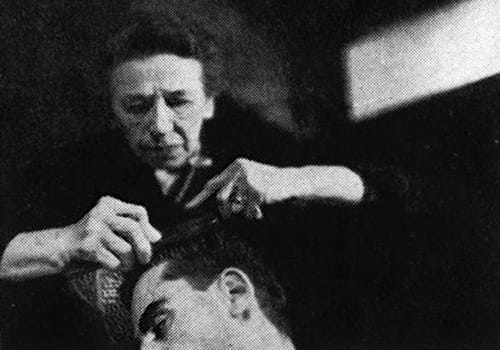
1953 Rose Laird treating a male client.
Other innovations developed during this time included Shaperone (1937) a hand cream that could also be used to soften roughened areas such as the elbows, knees, and heels, and Tanologne (1939), an Eau de Cologne formulated with an unknown sunscreen.
Shaperone: “Created specifically to counteract chapping, rough and reddened skin. It is lubricating, softening and soothing: leaves no greasy stains.”
Tanologne: “[A] delicious smelling eau de cologne containing mysterious properties said to screen out the rays that burn.”
Young Skin
The Young Skin series (1938) was an innovative, forward-thinking development in a market that would become increasingly important after the war. Built on existing lines that Rose Laird had developed for adolescent skin types the Young Skin range added make-up, packaging it with an extended skin-care range in matching containers.

Above: Rose Laird Young Skin range packaged in snowy-white containers with marine-blue lettering. Blue and white polka-dotted ribbons were tied around the necks of the bottles and the pattern was also used on the lipsticks and face powders.
Skin-care cosmetics in the Young Skin range included soaps and other cleansers, lubricants and other skin creams. Resorcinol was used to control bacteria, zinc oxide to hide blemishes, and salicylic acid to act as an exfoliant.
Young Skin Cleansing Cream: “[F]or normal or dry skins—a white and fluffy cream containing an emollient to help prevent drying natural skin oils.”
Young Skin Liquid Cleanser: “[W]ith a mild astringent action for the removal of the last traces of the cleansing cream.”
Young Skin Liquid Facial Soap: “A lovely lathery liquid that gets right to work on the excess oil common to problem skins. Used with a complexion brush.”
Young Skin Greaseless Lubricant: “It lubricates without benefit of oil, grease or wax – which are unkind to blemished skins. Agrees with the most sensitive skin and softens beautifully.”
Young Skin Overnight Ointment: “An efficient, medicated preparation that fights blemishes every step of the way. Use before going to bed as on all-over mask – or concentrate on blemished areas. Spread lightly – leave on overnight.”
Oily Skin Cream: “[A]bsorbs the distressing excess oil that is the bane of so many young persons’ loveliness. It is snow-white and fragrant. No more shiny noses and chins. You can powder right over it in the daytime, too!”
Adolescent males were not forgotten and the line also included a Young Skin Medicated Brushless Shaving Cream and Young Skin Medicated After Shave Lotion. There was also Young Skin Scalp Lotion in two forms, one for normal hair and one for dry, and a small make-up range consisting of foundations, face powders and lipsticks.
Young Skin Base Cream: “[O]f a light consistency and besides being a good cosmetic foundation, protects the skin against chapping, sun or windburn.”
Young Skin Protective Make-up Film: “It makes you lovely, helps conceal imperfections and lasts the day long. An antiseptic, medicated product that benefits as it beautifies. No ‘make-up feel’. Shades: Pastel, Light, Medium, Brunette, and Dark but was in Petal Pink, Cinnabar, and Rusglo by 1945.
Young Skin Face Powder: “So soft – so fine! It clings tenaciously but never cakes, streaks or clogs. Delightfully fragrant.” Shades: Pastel, Light, Medium, Brunette, and Dark but was in Petal Pink, Cinnabar, and Rusglo by 1945.
Young Skin Lipstick: “Creamy-smooth yet lasting. Will not pucker or dry young lips.” Shades: Natural, Light, and Medium but was in Brilliant, Raspberry, Real Red, and Petal Pink by 1945.
To promote the line, Rose Laird set up Young Skin booths in department stores beginning with Bonwit Teller in New York. Staffed by Young Skin counsellors the booths dispensed products and advice. Rose Laird would later package the Liquid Soap, Overnight Ointment, Greaseless Lubricant, and Protective Lotion together into the Young Skin Kit. A later Dorm Chest combined Young Skin Liquid Lather, Liquid Cleanser, Greaseless Lubricant, Face Powder, and Lipstick.
Make-up
The only major make-up line, apart from those in the Young Skin range, introduced by Rose Laird between 1935 and the Second World War was Skintone Foundation. Unfortunately, I know almost nothing about it. Developed by 1938 at the latest, this waterproof foundation was suitable for all skin types. It was applied thinly and evenly over the face and throat then patted in with a little water. Once it was dry it could be powdered down.
Skintone Foundation: “It protects the normal skin, covers all blemishes, birthmarks and white nerve spots and keeps a lasting matt appearance.” Shades: Lotus, Petal Pink, Rusglo, and Beachtan.
Other developments included the introduction of an automatic lip liner (1938) and the creation of a range of fruit flavoured lipsticks (1941) in Raspberry, Strawberry, Pineapple, Orange, Lemon, and Lime flavours.

Above: 1938 Rose Laird Lip Liner. The pencil point appears by twisting the bottom which also indicated the shade. The cover is in aquamarine lettered in white.
There were also some new make-up shades such as Tulip Red (1937), Foxglove (1939), Mink (1940), and Red Coal (1940).
Rose Laird continued to promote corrective make-up/contouring when applying make-up, a practice developed by movie make-up artists in the 1930s to make film stars look their best.
Rose Laird is teaching her clients a fascinating new principle of make-up, the art of bringing out the most desirable features through the use of shadows.
“Based on the sound theory of camouflage, there is no reason why any intelligent woman, given the correct pallette [sic.] of colors and shadow effects, cannot learn to minimize her less attractive features and highlight her best ones.” she declares.(Rose Laird advertorial, 1937)
As well as contouring, Rose Laird also provided suggestions on how best to colour coordinated her make-up using hair colour as a reference point.
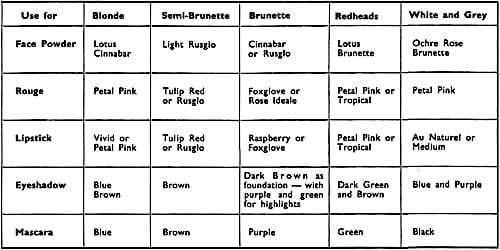
Above: 1938 Rose Laird Make-up Chart.
Also see: This Way to Loveliness (c.1938) and Corrective Make-up (Contouring)
War
The war cut Rose Laird off from Britain and her factory in London was bombed more than once. Despite this, her products continued to be available there throughout the war. I have been unable to find any new additions to her product range during the war except for Leg Tone (1942), a leg make-up. It joined a number of similar products developed during the war when nylon and silk stockings became scarce.
Leg Tone: “[T]he finest leg makeup ever produced. Simple to use. Can be patched without showing. No rain worry. Will dry out and never show a mark.” Shades: Cinnabar, Rusglo, and Light Rusglo.
See also: Cosmetic stockings
Post-war
In 1951, Bostonians honoured Rose Laird by including her in the first ‘Assembly of American Women of Achievement’ as a pioneer in cosmetics for young and old alike.

Above: 1951 Assembly of American Women of Achievement. Rose Laird is third from the left in the middle row – she would have been in her seventies when the photo was taken. LIFE magazine states that she received the award for an indelible lipstick which suggests that LIFE was confusing her with Hazel Bishop.
See also: Hazel Bishop
The 1950s saw some dramatic changes in the American cosmetic market associated with rising expectations from the American consumer and an increased use of expensive television advertising. Unfortunately, Rose Laird was not in a good position to cope with these changes.
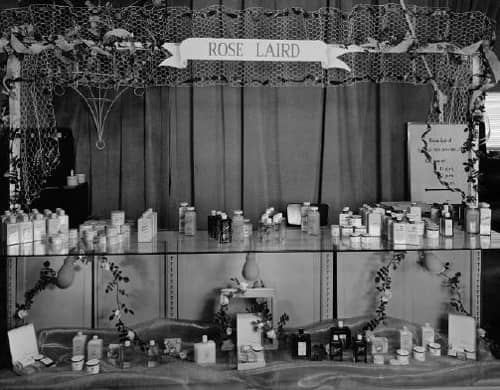
Above: 1951 Display for Rose Laird products featured during the ‘Fragrance, Beauty and You’ show at The J. L. Hudson Company Department Store (Detroit Historical Society).
Personal interactions between Rose Laird and her clients were an important part of the way she promoted her products and she put a great deal of effort into maintaining relationships with past and potential clients through personal appearances in stores, by giving talks to various community groups and through interviews with beauty commentators. This marketing strategy, largely based on Rose Laird being almost constantly on the move, worked reasonably well before the war but suffered in the post-war environment when living standards and expectations rose, clients moved to the suburbs and turned to television.
To add to its problems, one of the company’s strength – its products marketed for younger problem skins – came up against increased and better-funded competition. After Noxzema introduced Cover Girl in 1961, the majors became more interested in marketing cosmetics to teenagers and young women, developed lines specifically for them, and promoted them through national television and print advertising campaigns. Unfortunately, Rose Laird had limited resources to counter this competition.
See also: Cover Girl
The increased competitive pressures seems to have pushed Rose Laird towards specialising in cosmetics aimed at specific skin-care problems. Many of her new products came with names that made them sound like medicinals that were ‘formulated to care for complexion difficulties’.
Skin-care
The first new line released by Rose Laird following the Second World War was Atrogen Cream (1945) containing the synthetic hormone stilboesterol (diethylstilbestrol) along with oxycholesterins. Rose Laird was an early adopter of diethylstilbestrol, developed in 1938, and naturally suggested applying it using her knuckle massage technique.
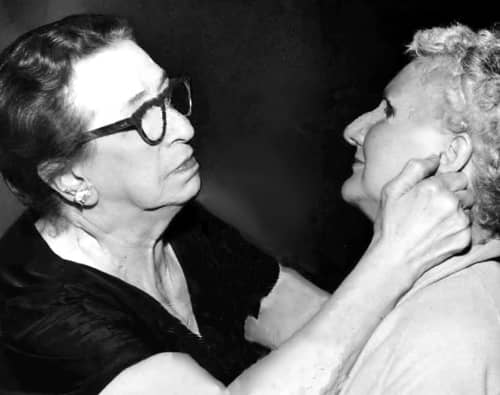
Above: 1956 Rose Laird demonstrating knuckle massage to a client.
Atrogen Cream: “[W]hips up the small blood vessels that feed the skin into new vitality and the dull sluggishness is gradually ‘energised” away and replaced by a smooth healthy elasticity.”
Also see: Hormone Creams, Oils and Serums
Atrogen Cream was followed by the Thelium Treatment range in 1950. Designed for more mature skin types, the range consisted of a cleanser, toner, lubricating cream and masque, with an After-Bath Lotion and Dusting Powder added by 1959.
Thelium Liquid Cleanser: “[C]leanses deeply.”
Thelium Massage Cream: “Invaluable for thin and excessively dry skins. Helps nature to keep the skin vibrant and flexible by augmenting the diminishing supply of natural oil.”
Thelium Skin Bracer: “An invaluable Rose Laird preparation to stimulate and brace mature skin which is apt to be excessively dry and inactive.”
Thelium Liquid Masque: “[A] pink fluid smelling faintly of camphor, very gentle and soothing.”
As with the Atrogen Cream, knuckle massage was again suggested when applying the Thelium Massage Cream.
First, cleanse with Thelium Liquid Cleanser, which is a soft creamy emulsion. Work it well into the skin, from the neck and upwards over the face, and then wipe off with tissues. You will find that it cleanses deeply. Next, massage with Thelium Massage Cream. Rose Laird’s advice is to “knuckle” it in all along the contours and the jaw-line, and then knead it gently up the neck and face. Blot the excess cream away, and leave it to do its work of nourishing and smoothing out the skin during the night. In the morning, cleanse again with the Liquid Cleanser, and then stimulate with Thelium Skin Bracer. For an evening “pick-me-up” before going to a party, use the Thelium Liquid Masque. Unlike most masques, this is a lotion. Pat it on, leave for about ten minutes, and then wipe it off with a damp towel. If you are feeling weary, it revives you wonderfully quickly, and completely wipes out that tired look.
(Rose Laird advertorial, 1956)

Above: Rose Laird Thelium Massage Cream and Rose Laird Young Skin Overnight Ointment.
For younger skins, Rose Laird continued to promote her Young Skin range. In 1946, she combined Young Skin Protective Lotion, Liquid Lather, Liquid Cleanser, Lipstick and Face Powder into a Dream Girl box and used the actress Betty Field to promote the line.
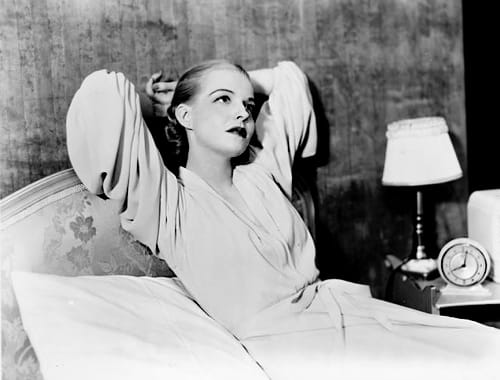
Above: 1946 Betty Field [1913-1973] appearing as Georgina Allerton in Dream Girl which ran on Broadway between 1945 and 1946. The picture was used by Rose Laird in Dream Girl advertisements.
Although Young Skin Liquid Facial Soap, Overnight Ointment, Greaseless Lubricant, and Protective Make-up Film remained the four main treatments in the Young Skin range, Rose Laird also provided her clients with information on how to get the best from these and other skin-care products in her range.

Above: c.1945 Rose Laird Directions Chart.
In 1948, Rose Laird added Fresh-Up, a liquid cleanser with a cooling effect.
Fresh-up: “[A] liquid cleanser that is as refreshing as a cool shower on the face. It will even take the place of a cream or soap cleanser, for it removes all kinds of dirt and dust that ordinary cleansers can’t.”
The only other known skin-care products developed after the war were Solution P-5 and Ointment P-5 (1960) for psoriasis; and Thelane 4 (1964), a moisturiser for use under make-up.
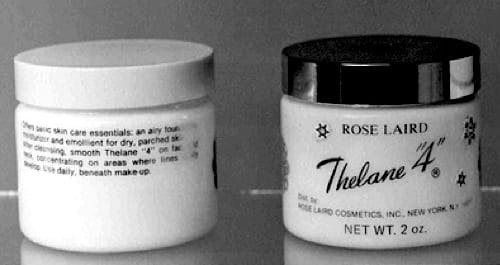
Above: Rose Laird Thelane 4.
Solution P-5 and Ointment P-5: “[Their] soothing, penetrating action gently kills germs, moisturizes scales away and banishes itching discomforts. Invigorates new cell growth, stimulates healthy, youthful, glowing beauty.”
Thelane 4: “[A]n airy foundation, moisturizer and emollient for dry, parched skin.”
Make-up
Rose Laird looks to have rationalised her make-up range somewhat during the war and integrated its make-up colours across her general and Young Skin ranges. Shades available immediately after the war were as follows: Protective Make-up Film – Petal Pink, Cinnabar, and Rusglo; Face Powder, – Brilliant, Lotus, Cinnabar, Rusglo, Ochre Rose, and Light Rusglo; Rouge – Brilliant, American Beauty, Raspberry, Cinnabar, Light Red, Medium Red and Rusglo; Lipstick – Red Suede, Luscious Red, Foxglove, Winterberry, Red Coal, Brilliant, Real Red, Raspberry, Petal Pink, Cinnabar, Logan Berry, Oxblood, and American Beauty; Eyeshadow – Royal Blue, Dark Blue, Brown, Turquoise, Emerald Green, Gray-Blue, and Dark Green; and Mascara – Dark Blue, Green, Brown, Blue Black, and Dark Green.
The shades were coordinated with hair colour – Blonde, Ash Blonde, Brunette, Brunette with red highlights, Titan Redhead, Copper Redhead, Brownette, and Gray but Rose Laird also provided information on how to match lipstick shades with clothing colours.

Above: c.1945 Rose Laird lipsticks match to clothing colours.
It would appear that not all of the make-up shades listed above were available in the Young Skin range. I also have no information of any later additions to the shade range and no material on whether or not Rose Laird continued to sell nail polishes after the war. It is possible that she ceased polish production during the war when nitrocellulose supplies became limited and decided not to resume the range after 1945.
Information on new Rose Laird post-war make-up products is limited to Pat-Tint (1946) a cream foundation that did not require powdering.
Pat-Tint: “[A] moist powder make-up that lasts all day without wearing powder. For normal skin.”
Sale
In 1966, Rose Laird died leaving a will that listed her chief chemist, Irving Wexler, as her major legatee. In 1969, the American arm of Rose Laird was sold by Wexler to Carmen Cosmetics for about US$175,000. Carmen Cosmetics was established in 1951 by Carmen Murphy in Detroit, Michigan to market cosmetics to African Americans. Wexler stayed on as company president and presumably helped adjust the Rose Laird cosmetics to make them more suitable for African American skin types. Rose Laird cosmetics seem to have disappeared from the American stores after this date, but were sold through direct mail until at least 1989.
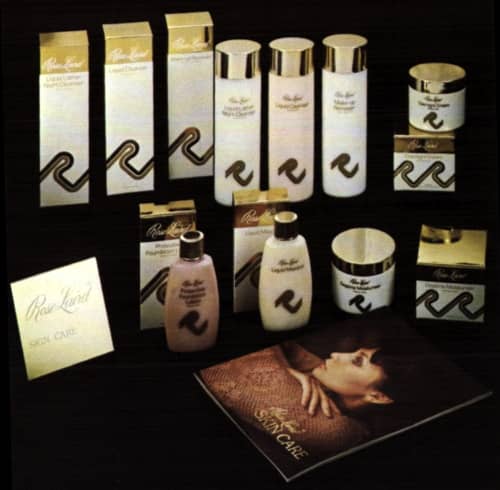
Above: 1978 Rose Laird range repackaged by Purex Industries Inc. after one of its subsidiaries acquired the Rose Laird line in 1977.
The British arm of the company seems to have operated independently until it was sold to International Laboratories in 1974. The new owners repackaged and relaunched the line and added some products, most notably the Callista line (1974) for combination skins. Rose Laird Ltd. then went through a series of owners including: the Brillo Manufacturing Company of Great Britain (1977), a subsidiary of Purex Industries, Inc. who then placed it under the control of Cuticura Laboratories, another company they owned; Innoxa (England) Ltd. (1981); and Silhouette International Ltd. (1986). Silhouette repackaged the line in peach, grey, and silver for the professional beauty salon market bringing to an end sales of Rose Laird as a general consumer product.
Timeline
| 1936 | New Products: Solo Cream; and Solo Masque. |
| 1937 | New Products: Shaperone Hand Cream; Cream Deodorant; and Deluxe Face Powder. |
| 1938 | New Products: Young Skin range; Dry Skin Cream; and Lip Liner. |
| 1939 | New Products: Tanologne. |
| 1942 | New Products: Leg Tone. |
| 1945 | New Products: Atrogen Cream. |
| 1946 | New Products: Pat-Tint. |
| 1950 | New Products: Thelium range. |
| 1960 | New Products: Solution P-5; and Ointment P-5. |
| 1964 | New Products: Thelane 4. |
| 1968 | Rose Laird Ltd. (UK) move to Stephenson Street, London. |
| 1969 | Rose Laird (USA) sold to Carmen Cosmetics. |
| 1972 | Rose Laird Ltd. (UK) moves to Sewell Street, London. |
| 1974 | Rose Laird Ltd. (UK) sold to International Laboratories. |
| 1977 | Rose Laird Ltd. (UK) sold to Purex Industries Inc. |
| 1978 | Rose Laird (UK) line repackaged. |
| 1981 | Rose Laird Ltd. (UK) sold to Innoxa (England) Ltd. |
| 1986 | Rose Laird Ltd. (UK) sold to Silhouette International Ltd. |
| 1990 | Rose Laird (UK) line repackaged. |
| 1992 | Rose Laird (UK) skincare bought by Anthony Green Ltd. |
First Posted: 17th May 2016
Last Update: 14th October 2023
Sources
Laird, R. (1935). Personalising cosmetics. The Drug and Cosmetic Industry. 37(1), 58-59.
Rose Laird. (1935). To your natural beauty give protection … to any blemish give correction [Booklet]. New York: Author.
Rose Laird. (c.1938). This way to loveliness [Booklet]. England: Author.
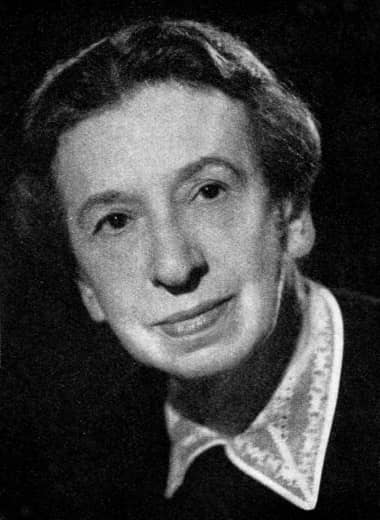
Rose Helen Laird (née Graeser) [1880-1966], later Rose Helen Laird Kingstone.
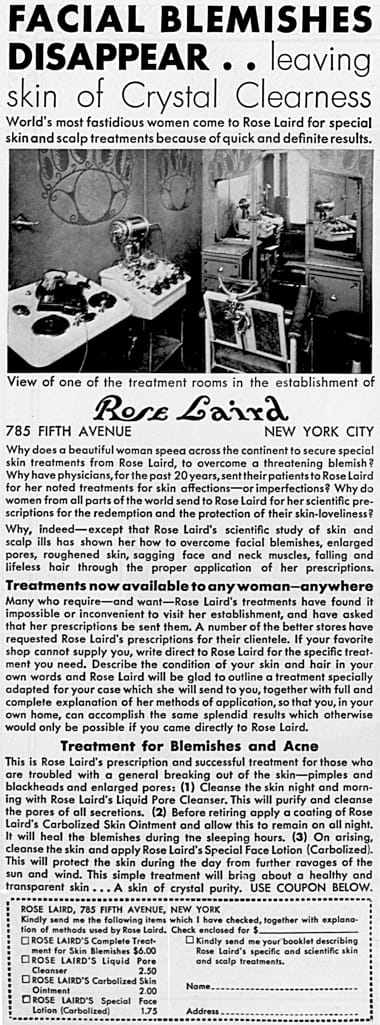
1930 Rose Laird salon treatments.
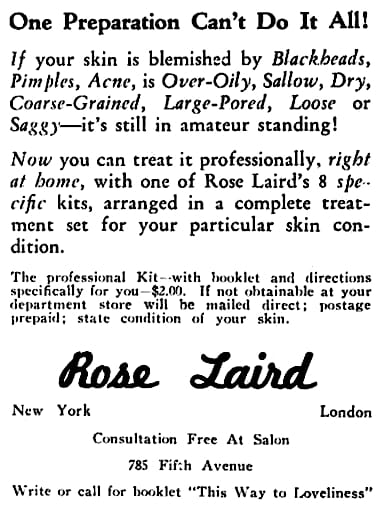
1937 Rose Laird Professional Kit.
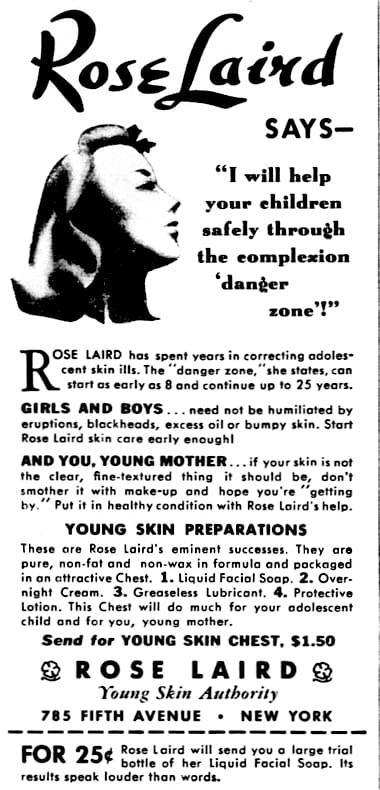
1940 Rose Laird Young Skin Chest.

1940 Rose Laird Dorm Do-All Chest.

1941 Rose Laird. Young Skin Authority.

1941 Rose Laird. Young Skin Counselor.
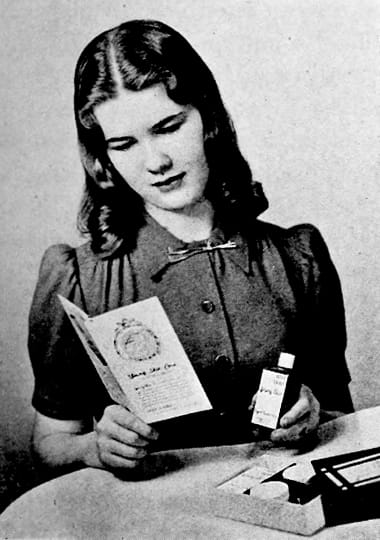
1943 Rose Laird Young Skin kit.
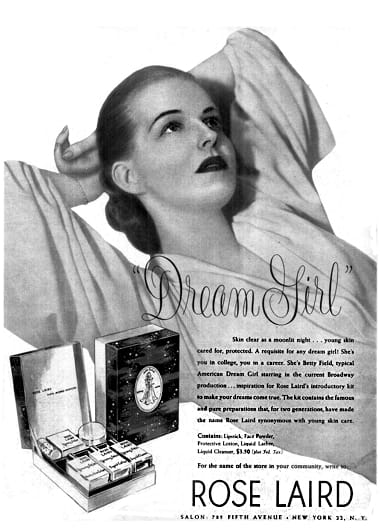
1945 Rose Laird Dream Girl box containing Young Skin Liquid Cleanser, Liquid Lather, Protective Lotion, Lipstick, and Face Powder with Betty Field on the lid.

1945 Rose Laird Protective Make-up Film.
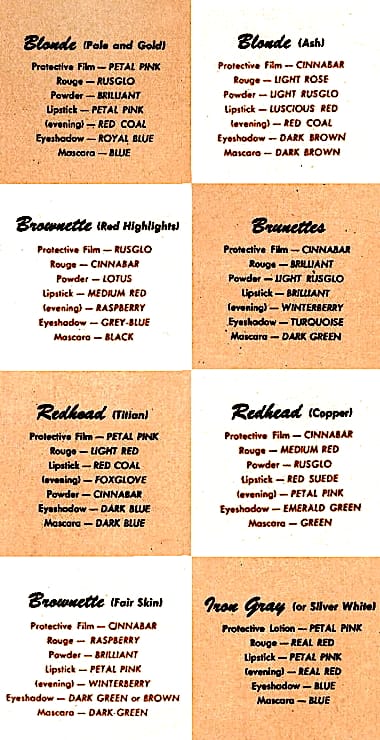
c.1945 Rose Laird Color Chart.
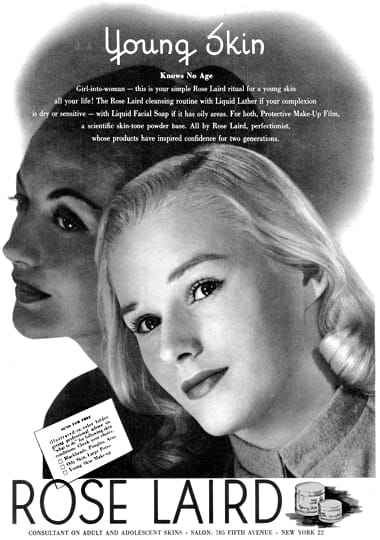
1946 Rose Laird Young Skin.

1948 Rose Laird Purse Kit containing Fresh-Up, Protective Make-up Film and a lipstick.
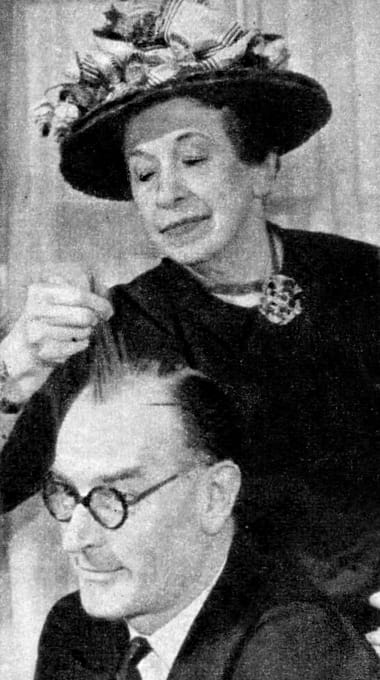
1950 Rose Laird pulling hair to stimulate the scalp (London).

1951 Carmen Murphy [1915-1991] (right). The Carmen Cosmetics line was designed especially for ‘women of color’ by Rose Laird’s chemist, Irving Wexler. Murphy bought the American arm of Rose Laird in 1969.
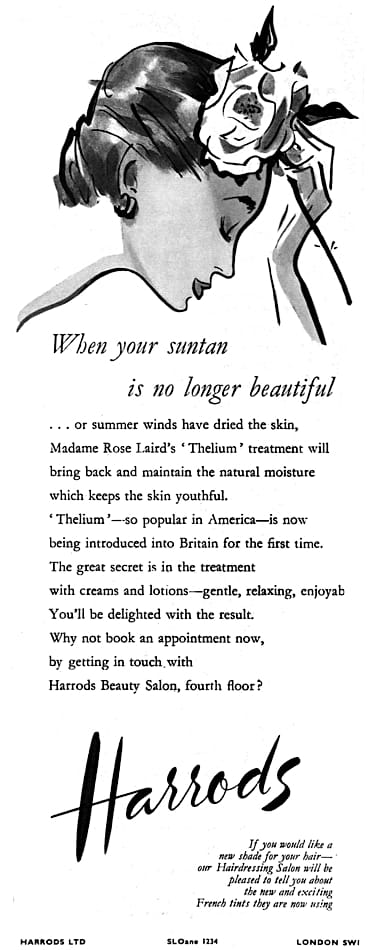
1956 Rose Laird at Harrods (Britain).

1959 Rose Laird (Britain).

1963 Rose Laird night and morning treatments for bad skin using a mixture of Young Skin and other lines (Britain).
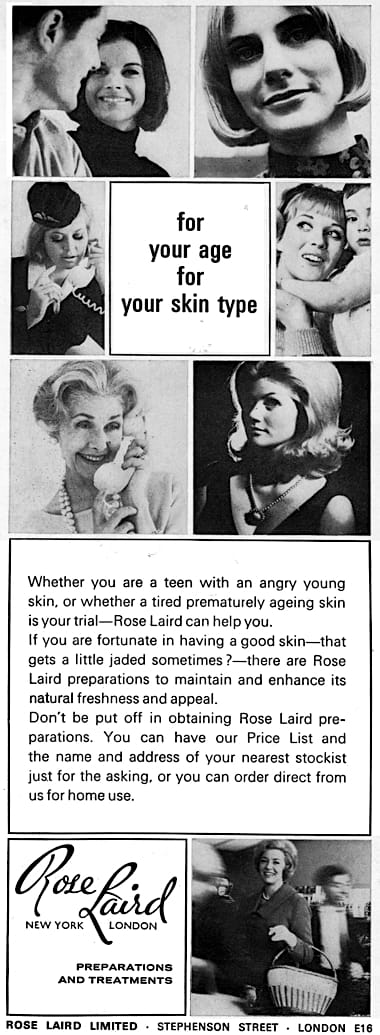
1969 Rose Laird (Britain).
